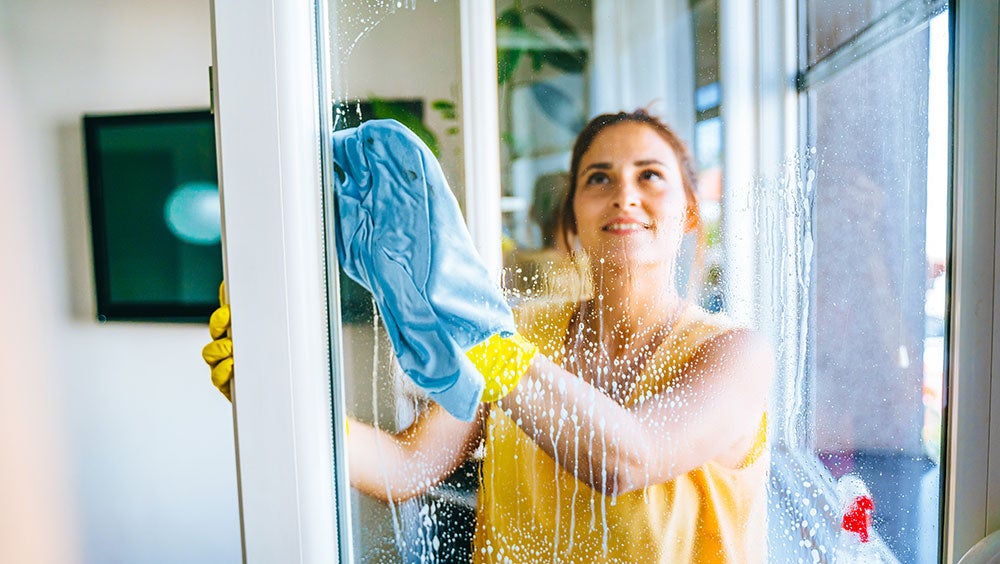Getting That Streak-Free Shine Without Ammonia: Safer Choice Glass Cleaners That Really Work

If you’re responsible for keeping a facility looking clean, you know that keeping glass windows and mirrors dry and without streaks is critical. But perhaps you have wondered why you need a special cleaner for glass. A bit of residue or streaking may go unnoticed on some surfaces, but on glass, streaking or residue left behind is obvious and makes surfaces look dirty. When cleaning glass, it is important to have a product that evaporates quickly to prevent visible residue from forming on the surface. Traditional water-based cleaners are more focused on removing soils, grease, and grime and are great on many surfaces, but when used on glass, they can leave water marks and streaks.
Components of a typical glass cleaner
Because glass and mirrors have unique needs, products used to clean these surfaces should do three things:
- Wet the surface well.
- Clean the surface.
- Evaporate quickly to leave a streak free shine.
All-purpose cleaners tend to remove soils and wet surfaces well, but do not typically evaporate quickly. Also, traditional cleaners often have added fragrances to provide a pleasant scent.
Glass cleaners on the other hand are made with different ingredients that make them work especially well on shiny glass and mirrored surfaces:
- Solvents. Glass cleaners contain high levels of solvents, such as ammonia and alcohol, that evaporate quickly and are less likely than water to leave streaks.
- Surfactants. These are the cleaning ingredients that remove grease, grime, and dirt from surfaces. Glass cleaners usually have lower levels of surfactants than traditional cleaners to avoid leaving residue on surfaces.
- Glycerin. Glycerin is a compound that can help wet the surface evenly. All-purpose cleaners do not need glycerin because they are water-based which already wets surfaces well.
- Fragrance. Added fragrances are important for leaving a pleasant smell, but fragrances tend to be oil-based, which can leave streaks and residue on surfaces. That’s why glass cleaners tend to have low or no fragrance added.
The overall formula and relative amounts of each ingredient are distinct to each product and contribute to how well a product works.
Ammonia in glass cleaners — a necessary evil or just unnecessary?
Ammonia is an effective solvent in glass cleaners because it evaporates quickly and is less likely to leave streaks. However, ammonia may cause respiratory irritation among more sensitive populations and can become dangerous if mixed with chlorine-containing products1. While ammonia-based cleaners are safe when used as directed, it can provide peace-of-mind to facility managers to find a glass cleaner that is made with ingredients that pose fewer risks related to accidental mixing, skin contact, or inhalation. There are ammonia-free glass cleaners available that are just as effective at cleaning, while being a better choice for front-line cleaners and janitors.
Looking for an ammonia-free glass cleaner? Look for the EPA Safer Choice seal. Safer Choice certification requires cleaning products to meet high standards for human health and the environment, and under these standards, ammonia is not an acceptable ingredient.
Choosing an ammonia-free glass cleaner without sacrificing efficacy
Efficacy as a glass cleaner is measured based on a standard streaking test that rates products 1-4. The gold standard glass cleaner achieves a “streak free” rating, or 4/4 on the streaking tests. Under the EPA Safer Choice program, cleaning products must show performance comparable to traditional products. Per the Safer choice Standard2, a glass cleaner meets certification requirements for efficacy if it achieves at least 3/4 on the streaking and residue tests.
So look for the Safer Choice certification to find a glass cleaner that really works, without the downsides.
Find Safer Choice Certified glass cleaners
To find a Safer Choice Certified glass cleaner for your facility, follow the link below and sort product type for window/glass cleaners.
https://www.epa.gov/saferchoice/products
References
1. The Facts About Ammonia [Internet]. Available from: https://www.health.ny.gov/environmental/emergency/chemical_terrorism/ammonia_general.htm#:~:text=Exposure%20to%20high%20concentrations%20of,and%20nose%20and%20throat%20irritation.
2. Safer Choice Standard and Criteria [Internet]. Available from: https://www.epa.gov/saferchoice/standard






